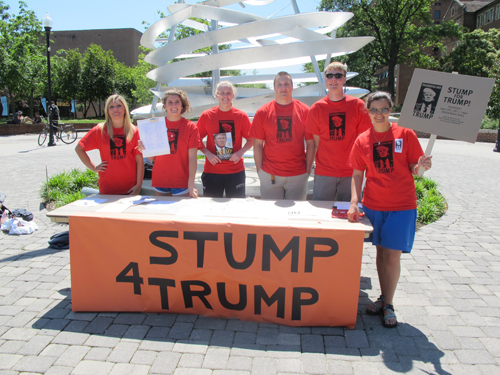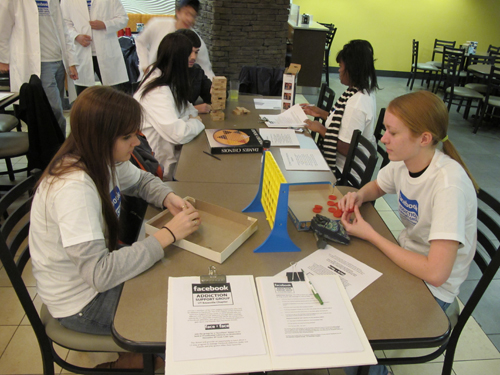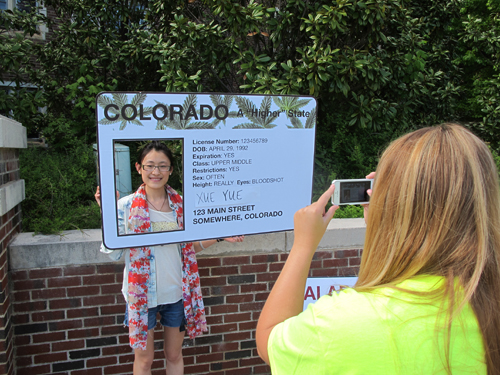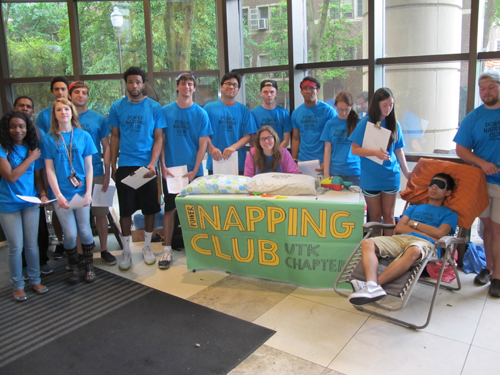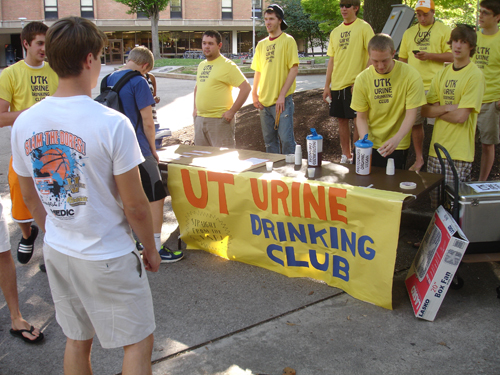
TEACHING PRANKS
FIRST YEAR STUDIES FRESHMAN SEMINAR 129: PRANKS
Why do we find pranks on Punk’d and Jackass so interesting? In this course we will study and stage a number
of pranks during the semester to explore the social, political, ethical and artistic uses of the prank. The
ARTOFTHEPRANK.COM web site will be the major resource for the seminar. Course materials are on a Blackboard
Site that includes numerous web links to historical and contemporary pranks. A partial list includes Jonathan Swift,
H.L. Menken, Candid Camera, Improv Everywhere, Mock-Academics, Joey Skaggs, and the Yes Men. For the course
we complete five projects: (1) a prank letter to a corporation, company of government agency, (2) a group prank
in the spirit of Improv Everywhere, (3) an annotated bibliography of three articles from the Journal of Irreproducible
Results, (4) a prank flyer for a campus audience and (5) a final project where we invent a student club/organization.
As part of the course we also meet with a UTK Police Officer to discuss the ethics of pranks, and how pranks are
regarded from their perspective. The course is fun yet demanding, as students are asked to be active in discussions
and to open to collaboration.
The text above is for a First Year Studies Freshman Seminar (129), a one-credit, pass-no credit course that
I have taught at the University of Tennessee, Knoxville since the fall of 2009. FYS 129 courses wre initiated
to enhance freshman to sophomore retention by providing “small, discussion-based classes where you can
get to know other freshmen and a professor on a more personal level while studying topics that apply to your
interests and goals.” Tenure-track or tenured faculty members are eligible to submit course proposals on any
topic of their choosing and are paid a $1,500 research stipend. Seminars have included “Extreme Makeover:
Dorm Room,” “College-Life in the Movies,” “Harry Potter and Culture,” “The Music of the Grateful Dead,” and
“Can a Robot Have a Mind?” The students enrolled in the Pranks course have come from many different degree
programs in the university, including agricultural sciences, architecture, arts and sciences, communications,
engineering, education, and social work, among others.
My interest in pranks has grown as a my own mock-academic studio projects with the Hokes (pronounced “hoax”)
Archives have moved outside of gallery and museums into more public contexts with a greater emphasis on
performance. My current project “The Association for Creative Zoology” involves the fabrication and documentation
of a fictitious creationist organization from the early 20th century. I have presented this project at the 2007 and
2010 John Scopes Trial Festival in Dayton, Tennessee as well as in 2010 at the Jefferson Garden of the American
Philosophical Society in Philadelphia. Dressed as a minister, I hand out religious tracts about the organization and
discuss the displays, which include lithographs and taxidermy that support the concept that God uses collage
techniques (or “zoomorphic juncture”) to create new species. Creative Zoologists point to dragons and unicorns,
both of which are described in the Bible as examples of God’s use of collage. In many respects, you might regard
this as a form of political pranking similar to the mock-conservative television personality Stephen Colbert.
The subject of pranks and art lead me to organize a panel session at the 2011 College Art Association on this topic.
The session examined aspects of pranking in modern and contemporary art, looking at the ways the prankster
operates as a trickster, creating deceptions that reveal larger truths while also calling attention to the relationship
between creativity and mischief. As a form of creative rebellion, pranks can critique social, political, religious and
institutional systems while raising ethical questions regarding deception and truth-telling. The session was a
tremendous success, with 21 papers submitted for consideration, and was the subject of a December 2011
ARTnews article by Ann Landi. CLICK HERE to read this article. While developing theories of pranks and their
role in modern and contemporary art is still a work in progress, it is clear that pranking has plentiful precedence
art of the past century, and is worthy of continued scholarly attention.
Pranking also has a rich history as part of college life. Indeed, one could argue that the academic quality of a
university might be measured in terms of the artistic and technical rigor of the pranks undetaken by students.
M.I.T.’s The “Hacks Gallery”, Columbia University’s Marching Band, and Cal Tech’s “Great Rose Bowl Hoax” of 1961
are good examples of universities known for academic excellence and a history of innovative pranking.
For many students the Pranks course provides an opportunity to engage in creative risk-taking as well as
collaborative decision-making, which are notably absent from their prior studies in high school. In some
respects the course offers students who are not art majors an academic experience more akin to a studio
arts course. Through extensive dialogue the students are encouraged to submit ideas and concepts for
peer review. Often class discussions examine questionsabout who is the target audience, and what are
the ethical implications of a specific prank.
This web page includes some examples of student projects from the five assignments that make up the course.
PROJECT 1: A PRANK LETTER
Based on examples from Ted Nancy’s book Letters from a Nut, students write a prank letter to a person, corporation
or government agency. While the student may use a pseudonym, it must have a working return address. All letters
are sent by regular post, and sometimes result in written responses. Printed here is a sample letter by chemistry
student Will Kilgore.
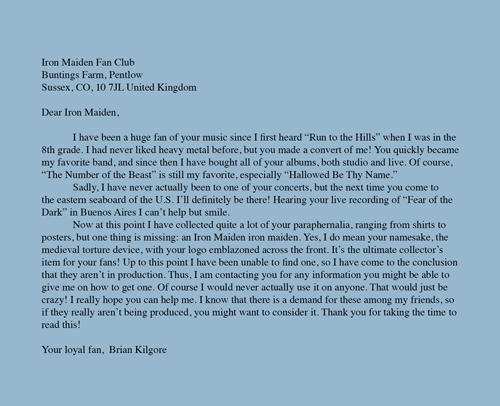
PROJECT 2: GROUP PRANKS
For this project various group pranks by Improv Everywhere and Candid Camera are studied. Some popular
examples include the “No Pants Subway Ride” and the “Free Hugs” movement. A good example is the
Improv Everywhere’s prank in which 111 men took their shirts off in an Abercrombie and Finch store where
a shirtless male model greets all customers as they enter and the store has numerous photographs of
bare-chested men. CLICK HERE to see the video. Pranks such as this raise issues regarding how products
are marketed through the objectification of the body, as well as the limits of creative civic protest in shopping
stores and malls.
Group Projects by the class have included performance/installations in library elevators, a cheerleading squad
for an intramural softball team, a mock “Running of the Bulls” on a campus pedestrian mall and fake customer
surveys in the main campus cafeteria. We even attached 160 helium balloons to a lawn chair offering scenic rides
and a
publicity eventwith "Marcello D," and imaginary adult film star. To see a You-Tube video of a flash-mob freeze
event that we have done a couple semesters, CLICK HERE.

PROJECT 3: THE JOURNAL OF IRREPRODUCIBLE RESULTS
The Journal of Irreproducible Results, a science parody magazine founded in 1955 has published mock-academic
articles representing a wide variety of disciplines, including the natural and social sciences, engineering, law,
economics and the humanities. Example articles include “Feline Reactions to Bearded Men,” “The Genetics of
Mermaids,” and “Which Came First, the Chicken or the Egg?” For this assignment, students compile short annotated
bibliographies on three articles from the journal. The purpose of this assignment is to expose the students to ways
that many of the best scholars and scientists are able to prank the conventions of their own disciplines. Experiencing
academic practice through this form of play is intended to empower students to think critically and creatively about
the academic enterprise.
PROJECT 4: A PRANK FLYER
For this project students create an edition of 20 fake posters for distribution throughout the campus. In preparation
we look at subversive posters created by the Los Angeles Cacophony Society in the 1980s as well as ways that
Ad Busters critiques messages we encounter in public spaces. Students learn some basic graphic design principles
and good sources for high resolution images. The flyers are in line the kinds of printed items that proliferate on
campus bulletin boards, and include fake lectures, clubs, events, political causes, job opportunities, as well as
items for sale, lost or found. Depicted here is an example by Matthew Garnett.

PROJECT 5: AN IMAGINARY STUDENT ORGANIZATION
The final assignment is a group project that involves setting up an information table or promotional
event for an imaginary student group or organization. The various course lectures as well as the four
prior assignments prepare the students for developing a concept that involves creative planning and
themes that have social and political currency. For each of these projects t-shirts are hand printed in
the UT School of Art Printshop that each student keeps as record of their participation in the course.
A the top of this page is a photograph of the "UTK Urine Drinking Club" which offered information on
the medical benefits of urophagia. Other examples include the "Stump for Trump," an effort to
collect sinatures to support Donald Trump to run for US President, and the "UTK Chapter of the
Facebook Addicition Support Group" which provided opportunities for students to make real friends
rather than just Facebook friends. The "Fake ID Club" provided an opportunity to make a fake ID
from Colorado or Alabama (on your camera phone). The "Zombie Attack Survival Club" advocated
for changing the university's Hazard Mitigation Plan to include future zombie attacks. The "Power
Napping Club" advocated that the university institute an afternoon siesta from 1:30-2pm daily for
all students, faculty and staff.
